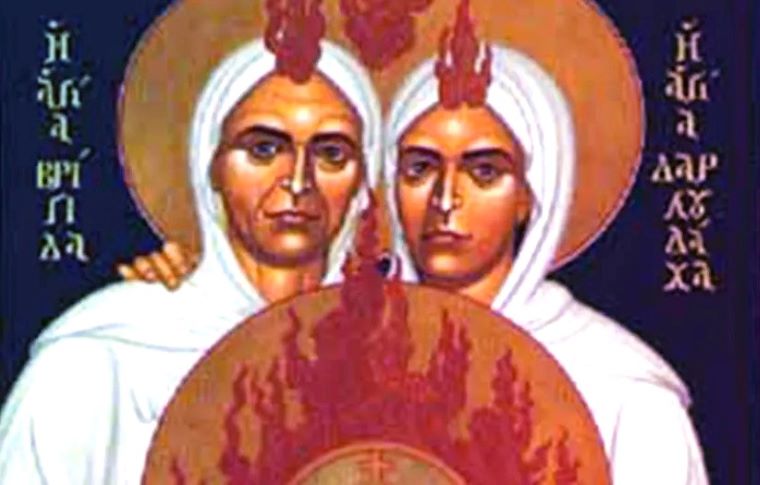
Brigid of Kildare and her soulmate Darlughdach were sixth-century Irish nuns who brought art, education, and spirituality to early medieval Ireland. Brigid (c. 451-525) shares her name and feast day (Feb. 1) with a Celtic goddess – and she may have been the last high priestess of the goddess Brigid. Her followers keep a flame burning for her.
In 2023 the Irish government added Saint Brigid’s Day as a new national holiday, the first to be named after a woman.
Raised by Druids, Brigid seems to have made a smooth transition from being a pagan priestess to a Christian abbess. Since medieval times Brigid has been called “Mary of the Gael” because of her similarity to Christianity’s central holy woman. Today she is Ireland’s most famous female saint. Her name is also spelled Bridget. Legend says that when she made her final vows as a nun, the bishop in charge was so overcome by the Holy Spirit that he administered the rite for ordaining a (male) bishop instead.
A younger nun named Darlughdach served as Brigid’s ambassador and her “anam cara” or soul friend. The two women were so close that they slept in the same bed. Like many Celtic saints, Brigid believed that each person needs a soul friend to discover together that God speaks most powerfully in the seemingly mundane details of shared daily life. The love between these two women speaks to today’s lesbians and their allies. Some say that Brigid and Darlughdach are lesbian saints.
Their relationship was put into a contemporary pop-culture context in an article by queer media critic Jessica Mason:
 “It was a very Xena and Gabrielle situation. They slept in the same bed, they lived and worked together, and one time when Brigid caught Darlughdach looking at a male warrior and made Darlughdach walk with hot coals in her shoes as penance,” she wrote.
“It was a very Xena and Gabrielle situation. They slept in the same bed, they lived and worked together, and one time when Brigid caught Darlughdach looking at a male warrior and made Darlughdach walk with hot coals in her shoes as penance,” she wrote.
Brigid started convents all over Ireland and became the abbess of the “double monastery” (housing both men and women) at Kildare. Built on land that was previously sacred to her divine namesake, the monastery included an art school for creating illuminated manuscripts.
After Brigid turned 70, she warned Darlughdach that she expected to die soon. Her younger soulmate begged to die at the same time. Brigid wanted her to live another year so she could succeed her as abbess. Brigid died of natural causes on Feb. 1, 525. The bond between the women was so close that Darlughdach followed her soulmate in death exactly one year later on Feb. 1, 526.
Both Christians and pagans celebrate St. Brigid’s Day on Feb. 1. People still celebrate her day by weaving twigs into a square “Brigid’s Cross,” an ancient solar symbol traditionally made to welcome spring. Feb. 1-2 is also known as Imbolc, a spring festival when the goddess Brigid returns as the bride of spring in a role like the Greek Persephone. Imbolc has been adapted not only into St. Brigid’s Day on Feb. 1, but also as Candlemas on Feb. 2. In many countries Candlemas festivities focus on Mary and the sacred feminine, including the Madonna of Montevergine who rescued a queer couple in medieval times.
Brigid’s main symbol was fire, representing wisdom, poetry, healing and metallurgy. The nuns at the Kildare monastery kept a perpetual fire burning in Brigid’s memory for more than a thousand years — until 1540 when it was extinguished in Henry VIII’s Dissolution of the Monasteries.
The Order of St. Brigid was reestablished in 1807. Two Brigidine sisters returned to Kildare and relit the fire in the market square for the first time in more than 400 years on Feb. 1, 1993. The perpetual flame is now kept at the Solas Bhride (Brigid’s Light) Celtic Spirituality Center that they founded there. In addition, anyone may sign up to tend St. Brigid’s flame in their own homes through the Ord Brighideach Order of Flame Keepers.




















Leave a Comment